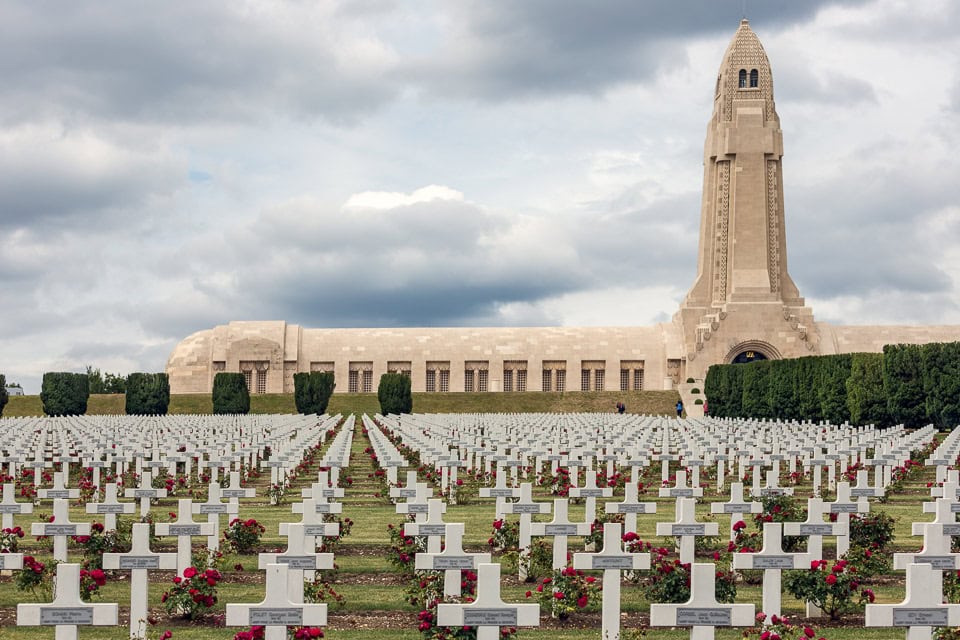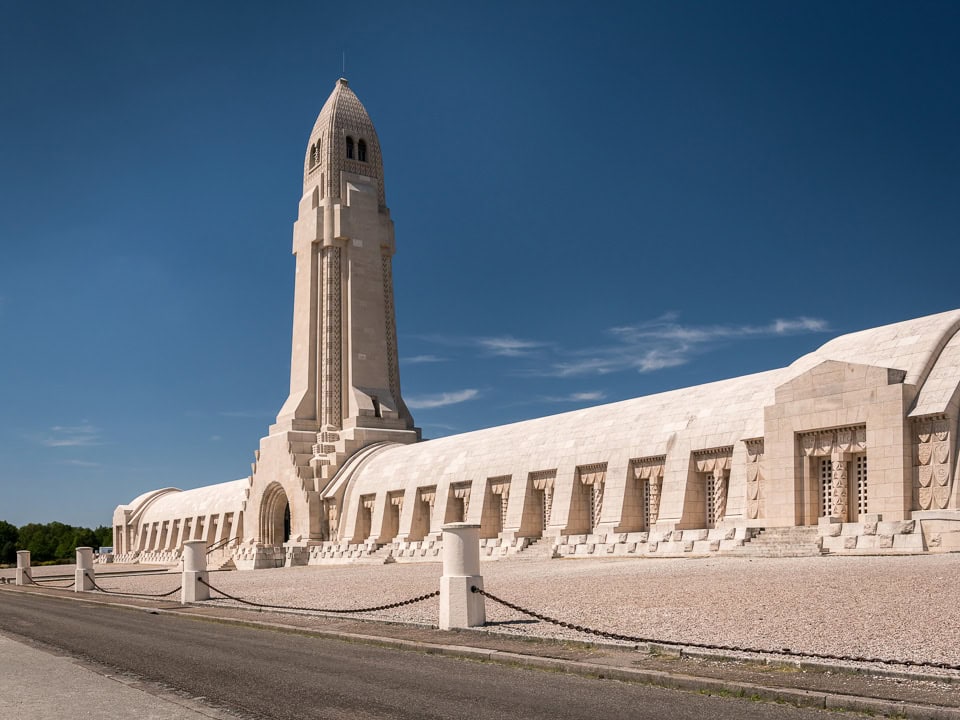Douaumont Ossuary- Memorial for the Battle of Verdun’s Unknown Soldiers
Purchases made through links earn us a small commission, at no extra cost to you.
The Douaumont Ossuary in northeastern France is a poignant memorial to the soldiers who died during the Battle of Verdun, the longest battle of World War I. This striking monument, erected on the Verdun battlefield next to the Fleury-devant-Douaumont National Necropolis, contains the skeletal remains of thousands of unidentified French and German soldiers who lost their lives during the 1916 conflict.

In This Post
History of the Douaumont Ossuary
After the 300 day Battle of Verdun claimed the lives of approximately 300,000 soldiers fighting for France and Germany, thousands of bodies were left on the battlefield unable to be identified. The idea for a memorial for the unknown soldiers was conceived in 1918 during the first hours of the Armistice after the bishop of Verdun, Monsignor Ginisty, visited the battlefield and saw the casualties without a respectful resting place.

The Douaumont Ossuary was designed by architects Léon Azéma, Max Edrei, and Jacques Hardy. Funds for the project were donated from countries, cities, and regions around the world. To show appreciation, the coats of arms of the 147 donors are mounted on the front facade of the monument.

During construction of the monument, the skeletal remains found on the battlefield were temporarily placed in a chapel. In 1927, even though the monument was still under construction, the first remains were relocated from the chapel to the ossuary. Eventually, the bones of 130,000 unidentified soldiers gathered from the battlefield were placed in the ossuary.

On August 7, 1932, the Douaumont Ossuary was inaugurated by President Albert Lebrun. Many years later, in 2023, the ossuary was inscribed as a UNESCO World Heritage Site as part of the First World War (Western Front) Burial Sites and Memorials.
Design of the Douaumont Ossuary
The Douaumont Ossuary memorial consists of three parts- the cloister, a central tower, and a chapel.
The Cloister and Ossuary
The heart of the memorial is the 137 metre long cloister that houses the ossuary.
Divided into two barrel-vaulted wings, the ossuary features a series of alcoves with sarcophagi representing the 46 sectors of the battlefield. Below the alcoves are vaults containing the remains of soldiers found in that sector. The piles of bones in the vaults can be viewed from outside through narrow windows at the back of the monument.

Inscribed on the walls and ceiling of the cloister are thousands of names of French soldiers who died during the Battle of Verdun. Some of the inscriptions are names of soldiers who fought in the area during World War II and veterans of the Indochina and Algerian wars.

The floor of the cloister is decorated with mosaics depicting war crosses and some other military decorations and orders of France. At the end of each wing are apses with more tombs and a memorial flame that is lit during ceremonies and important dates.
The Tower
In the centre of the building, the Douaumont Ossuary’s tower stands 46 metres tall, one metre for each sector of the Verdun Battlefield. The tower was a gift from the United States and offers visitors a view of the battlefield.

The tower is known as the Lantern of the Dead because red and white beacons shine from the top onto the battlefield at night. In addition to the lights, the top of the tower is home to a large bell cast in Orléans, named the Bourdon de la Victorie, that is rung during ceremonies. There also is a table that illustrates the layout of the battlefield.

The Chapel
One of the first parts of Douaumont Ossuary to be constructed was the chapel. Built in Roman-Byzantine style, the chapel features stained glass windows designed by Georges Desvalliers to depict the soldiers’ welcome to heaven after battle. Another artistic highlight of the chapel is the sculpture of Pieta on the main altar.
The chapel was a gift from French, Swiss, Belgian, American, and Canadian Catholics. The stained glass windows were donated by families of soldiers who fought in the Battle of Verdun.
Final Words
As one of France’s most important WWI memorials, the Douaumont Ossuary is worth visiting, particularly if you’re into military history because it’s an opportunity to learn about a significant battle and pay respects to the fallen soldiers.

Visiting Douaumont Ossuary can be a sombre, contemplative, and even emotional experience, especially when viewing the bones through the windows. It’s also quite touching how donations were gathered from around the world to build a respectable final resting place for the unknown soldiers. The ossuary has not only preserved the legacy of those who gave their lives for their countries, but it highlights the importance of remembrance in our collective history. For those reasons, Douaumont is one of the most esteemed ossuaries in the world.

Practical Information for Visiting Douaumont Ossuary
Location: Douaumont Ossuary is located in northeastern France at 55100 Douaumont-Vaux.
Hours: Current opening hours can be found here.
Admission Fees: Yes. Current prices can be found here.
Film: A 20 minute film about the Battle of Verdun and the ossuary’s history is shown in the theatre and provides important context for visiting the monument. Screenings are every half hour and the show is translated into English and several other languages.
Tours: Here is a trusted site where you can book tours to Douaumont Ossuary and other sites related to the Battle of Verdun.
Accommodations in Verdun
If you’re planning to visit Douaumont Ossuary and need accommodations, here is a list of hotels in Verdun. Please consider booking your Verdun accommodations through the included link. It costs nothing extra and helps support this website.


